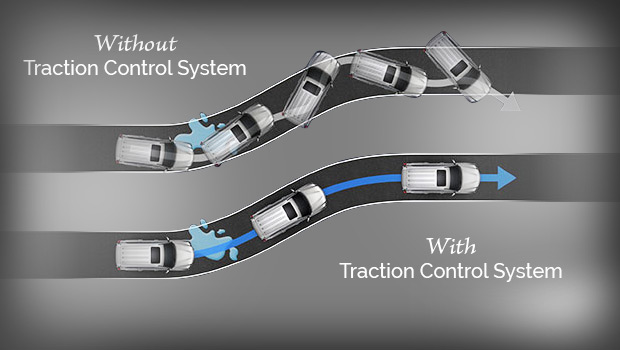Traction Control System is a well-known car safety feature that has become integral in ensuring the safety of the driver and passengers. Car brands are working tirelessly to improve the standard of car safety technologies offered in their new and upcoming cars. With the advancement in modern day technologies, car brands have been successful in developing advanced technological features that help to improve the safety of the occupants of a car and increase its reliability in challenging driving conditions.
Driving on wet roads and slippery conditions can be really troublesome even for seasoned drivers because the handling of the vehicle becomes a lot more difficult in such conditions. The vehicle can spin or slide off the road when the road is slippery, which can be dangerous for everyone sitting inside the car and other commuters on the road. A vehicle that slips or spins out of control can cause extremely dangerous situations, especially on roads with heavy traffic.
Traction Control System or simply Traction Control is a safety feature that ensures improved stability of the vehicle on wet roads and gives more control to the driver to stop the vehicle from slipping. Tyres without the Traction Control System become susceptible to slipping on wet roads and don’t maintain enough grip on the road, which endangers the safety of passengers.
Here is everything one must know about this safety feature, how it can help a driver and when it is most effective.
What is Traction Control System?
Traction Control is an active safety feature which ensures that the vehicle makes use of the maximum available traction on the road when driving on low-friction surfaces. If a vehicle with no traction system tries to accelerate on a slippery surface such as loose gravel, snow or ice, the tyres become vulnerable to sliding and slipping.
Without the Traction Control System, the tyres spin very quickly on a wet road because of reduced grip and stability. The driver can completely lose control of the vehicle in such circumstances and that can result in a dangerous road accident. However, this can be avoided with the Traction Control System as this cutting-edge safety technology improves a vehicle’s stability by adjusting the acceleration of the vehicle according to the road condition.
Traction Control System will activate automatically when it senses that the wheels might slip and helps the driver to make use of the maximum traction available on the road surface. This system only utilizes the available traction on a road to optimize acceleration of the vehicle and does not have the ability to create any traction of its own.
Traction Control is often a secondary function of the Electronic Stability Control, however, it is a complete safety technology that can perform its function independently as well.
When is Traction Control Most Effective?
This system is most effective when the vehicle is trying to accelerate on a slippery and uneven road. The effectiveness of the Traction Control System can increase even more if the driver remains attentive and drives slowly and carefully in slippery conditions. A proactive and safe driving approach coupled with Traction Control System can help in maneuvering a vehicle around sharp turns on a wet road with relative ease.
However, there are some limitations of the Traction Control System. This system does support the snow tyres and doesn’t improve the stability of the vehicle when driving in mud. Drivers are, in fact, advised to turn off Traction Control System if they are stuck in mud because in such driving conditions, this system doesn’t get any avaiable traction from the road.
Also read: Safe Practices for Driving in the UAE’s Bad Weather
Usefulness of Traction Control System
Traction Control System can be very useful in the driving conditions such as poorly maintained roads, loose gravel, uneven roads and wet roads. This safety feature can be useful when:
- Uphill drives – Trying to accelerate while going uphill on a path that is rough and uneven.
- Wet road conditions – Driving on a wet road that can cause the vehicle to slow down as the wheels will not get enough traction to speed up.
- Accelerating from standstill position – Trying to accelerate at a green traffic light on a wet and slippery road with traffic approaching from behind.
Many advanced Traction Control Systems reduce the power of the engine to manage the acceleration of the vehicle better on wet roads. It saves the vehicle from slipping and hence has its importance in avoiding a fatal crash. Drivers feel more comfortable when they have the Traction Control System in their vehicles because this system automatically adjusts the acceleration according to the condition of the road.
How to Make Best Use of the Traction Control System?
Even though Traction Control System is amongst the most common safety features, it has its limitations. Much like other safety features, the Traction Control System can only be useful if the driver makes an active use of this feature, which means a driver should be attentive on the road at all times. If the driver is not paying attention on the road, the Traction Control may not be able to help at all.
A safe driving approach will help the driver and the Traction Control System to maintain the stability of the vehicle. Traction Control System will be of no help if the driver is over-speeding or driving too aggressively.
This is the reason why motorists are advised to remain focused on the road, especially if the driving conditions are not supportive. Traction Control System is an exceptional safety technology with amazing utility in slippery road conditions for drivers who follow safe driving habits.
If you are planning to buy a new vehicle with advanced safety technologies and improved performance features, then don’t forget that with us, you can sell your used car in just 30 minutes while all the post-sale paperwork is handled by SellAnyCar.com’s team.




